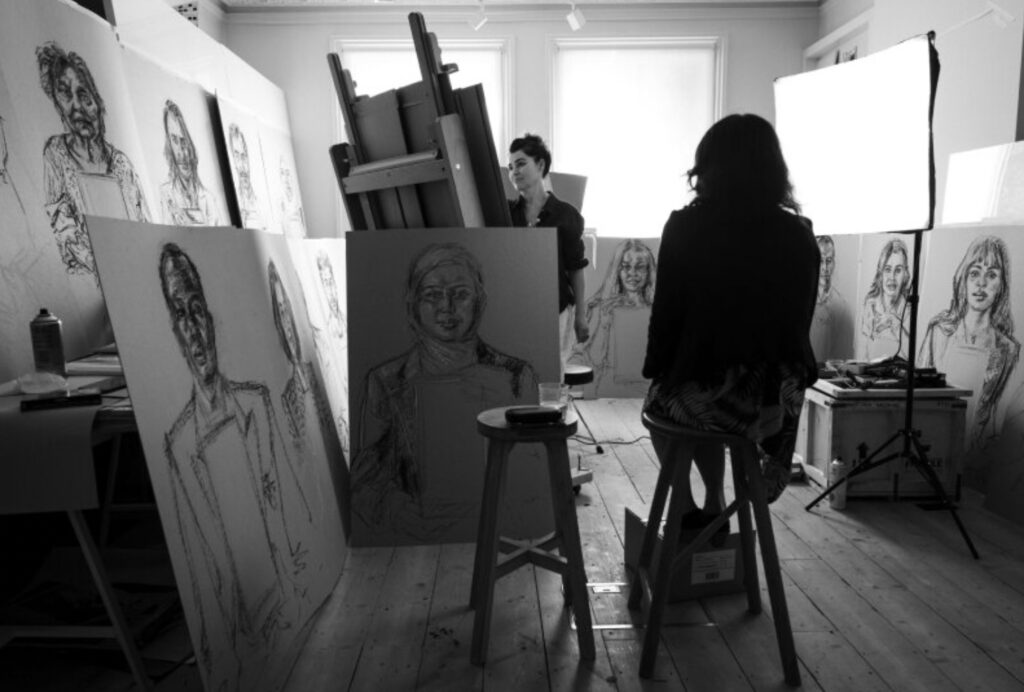
Es Devlin’s “Congregation”, a monumental art installation held at the 18th-century church of St Mary le Strand in London, explores the experiences of 50 displaced individuals who have come to London seeking refuge. The installation features large-scale chalk and charcoal portraits created by Devlin over several months, representing people who have fled from countries like Syria, Afghanistan, Venezuela, and Sudan. The artwork aims to humanize the diverse stories of displacement, providing a space for these narratives to resonate with viewers through a deeply personal and evocative portrayal.
Each portrait is a co-authored work, as the subjects contributed to the process by creating projected animated sequences, held in boxes that they display in the portraits. This collaboration with the participants allows Devlin to present them not merely as subjects but as active creators of the work, highlighting their agency and individuality. The installation also incorporates a sound sequence, composed by Polyphonia, which weaves together the voices and personal testimonies of the 50 individuals, creating a multidimensional sensory experience that engages both visual and auditory senses.
Devlin’s process for creating these portraits involved an intense, silent interaction with the sitters. She spent the first 45 minutes of each session drawing their likeness while listening to Max Richter’s “Four Seasons”. During this time, neither Devlin nor the sitter spoke, allowing a unique connection to form through sustained eye contact and the atmosphere of the room. After this silent drawing period, Devlin paused the music and conducted a conversation, learning about their stories and experiences. This interaction exposed her own preconceived notions and biases, as she realized how much her initial interpretations were influenced by superficial aspects like clothing or appearance before knowing more about their histories.
In curating this experience, Devlin connected with film director Ruth Hogben and choreographer Botis Seva to create a projection-mapped installation that visually animates the portraits and their stories. The drawings are shown in a tiered structure, reflecting the historical architecture of St Mary le Strand and the surrounding area, which has itself been a site of migration and refuge for centuries. The installation’s setting on the Strand, a street that has been a migratory artery in London since AD 93, further emphasizes the theme of movement and displacement that is central to the work.
Throughout the installation, Devlin draws on her own research into portraiture and the depiction of the human form, inspired by the works of Lucian Freud and Albrecht Dürer. The use of charcoal and chalk, with their raw and textured qualities, evokes a sense of fragility and impermanence, mirroring the precarious situations faced by those who have been forced to leave their homelands. Devlin’s previous work, “Come Home Again” (2022), similarly dealt with themes of belonging and loss, as she depicted London’s endangered wildlife in a choral sculpture of sound and drawing. With “Congregation”, she turns her focus to human subjects, bringing attention to the pressing issue of global displacement and the individuals who now call London home.
The installation not only serves as a platform for the voices of displaced individuals but also acts as a critique of societal attitudes towards refugees. By portraying each person’s journey and individuality, Devlin challenges the perception of refugees as a monolithic group, instead celebrating the rich diversity of backgrounds and talents they bring to their new communities. For instance, one participant, Maya Ghazal, who appears in a hijab in her portrait, surprised Devlin by revealing she is a commercial pilot. This encounter made Devlin aware of how easily assumptions based on appearance can obscure the depth and complexity of a person’s story.
The artwork culminates each evening with a choral performance by groups like the London African Gospel Choir, whose members also have refugee backgrounds. These performances are held outside the church and feature a repertoire that includes hymns and folk songs from the singers’ homelands. This live choral element creates a communal experience, reinforcing the installation’s message of connection and shared humanity. “Congregation” ultimately serves as a collective portrait of London, a city shaped by centuries of migration and cultural exchange, and as a call to empathy and understanding for all displaced individuals who seek safety and a sense of belonging.
No comments yet.








